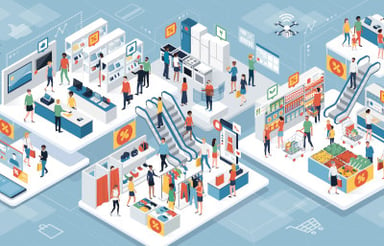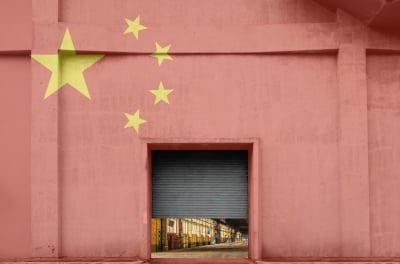Best in Manufacturing – September 07, 2021
Each Tuesday, we publish a list of top articles and other content related to manufacturing in areas like quality control, product development, supply chain management, sourcing, auditing and law.
1. What Are the Retail Giants Doing? Let’s Find Out.
 The retail industry is the largest industry in the world in terms of turnover and employment. Although the COVID-19 hugely impacted the physical retail chains, physical retail is still an enormous part of the industry. And the latest actions of the retail giants can be inspiring and might lead the trend within the industry.
The retail industry is the largest industry in the world in terms of turnover and employment. Although the COVID-19 hugely impacted the physical retail chains, physical retail is still an enormous part of the industry. And the latest actions of the retail giants can be inspiring and might lead the trend within the industry.
Let's start with Best Buy, the largest specialty retailer of consumer electronics in the U.S. This retail giant is raising its sales estimation as it sees a continuous trend in Work-from-Home (WFH) demand.
According to Best Buy, the retailer is still confident in the demand for home theater systems and computers/laptops due to WFH policy. The demand can possibly lift its sales in the second half of this year by 20 percent.
Best Buy is also expecting a sales increase in other aspects except for consumer electronics. Matthew Bilunas, the finance chief at Best Buy, said:
Our original outlook reflected a scenario in which customers would resume or accelerate spend in areas that were slowed during the pandemic, such as travel and dining out.
Tesco is shifting to sustainable carrier bags
Carrier bags are common for retail stores and mostly they are made of plastic, virgin plastic usually. And obviously, this is not eco-friendly. To save our planet, retailers are shifting to more sustainable options. Take Tesco for example, the shift happens in their carrier bags.
Instead of the plastic bag that Tesco used to sell, this retail giant now sells carrier bags made from plastic waste in its Eastern European market. As for now, the replacement has granted second lives to 150 tons of plastic waste in Hungary, the Czech Republic, and Slovakia. Those sustainable carrier bags are expected to reduce the use of plastic bags by 22 million a year.
You might ask: why don't we use paper bags? That's because the energy cost to generate a paper is rather high as well. Also, paper bags need to be thicker to carry goods but thus can be harder to break down in the environment.
Target is rolling out more sortation centers
Having all types of products isn't enough to satisfy customers these days. With more customers booking online and waiting for orders at home, faster delivery of the orders raises as the key point to win the customers.
To reach this goal, retailers are hiring more manpower for dispatching and delivering, and another secret weapon is the sortation centers.
For instance, Target announced recently to roll out 4 new sortation centers to extend its coverage. The new centers will take over the roles of the sortation process and free up the time and space in the backrooms and stores for more creative tasks.
Located in carefully calculated positions, the new sortation centers can better manage and send out the orders based on customers' preferences. Rebecca Swartz, Target's director of global supply chain and logistics, commented:
Then we're able to have a Target-controlled truck going to multiple different stores, multiple times per day and bring them to the sortation center.
In the future, Target might roll out more such sortation centers and more retailers may follow up.
Follow the link below to learn more about the recent moves of the giants in the retails industry.
Best Buy sees resilient work-from-home demand, raises sales forecast – Evelyn Cheng, Reuters
2. Consumer electronics manufacturers shifting back to China due to raging COVID-19
With the wide applying of the  Work-from-Home policy, the demand for consumer electronics keeps rising. Factories are busy making phones, laptops, computers to support people's work and life at home. Many brands used to source from China but under the pressure of the potential tariffs and rising labor costs, many manufacturers are moving to other Asian manufacturing hubs to save their budgets.
Work-from-Home policy, the demand for consumer electronics keeps rising. Factories are busy making phones, laptops, computers to support people's work and life at home. Many brands used to source from China but under the pressure of the potential tariffs and rising labor costs, many manufacturers are moving to other Asian manufacturing hubs to save their budgets.
However, some are moving back to China now. For instance, Google recently confirmed that it will manufacture its Pixel 6 series in China. This is Google's second relocation since it last moved out from China to Vietnam about a year ago.
According to Google, the major reason for shifting back to China is the travel restrictions due to COVID-19 and “limited technical resources” in Vietnam. Particularly, it’s because China’s well-developed manufacturing supply chain is able to support Google’s production with all the needed parts, without sourcing from other countries.
Shifts to Vietnam slow down
Though the production of Google's Pixel 6 series is moving back to China, the shifting to Vietnam of other production lines is still continuous but just slowed down.
Due to the potential risks aroused by the Sino-trade war, manufacturers have been moving out from China. For manufacturers of consumer electronics, Vietnam is the perfect alternative to go. Vietnam's young labor force and a short distance from China can make the transition easier. So, famous electronics brands like Google, Apple, and Microsoft soon started their relocation plan to move to Vietnam.
But due to COVID-19 travel restrictions, brands can’t send experienced engineers to assist in building the new manufacturing line in Vietnam. And the supply chain in Vietnam is yet not strong enough to support the production of the goods. Since the brands can’t simply move everything back to China, they have to slow down the shift.
Apple’s transition of MacBook, iPad, and AirPod manufacturing to Vietnam has been put on hold. Also, Amazon's production plan on its smart speakers, smart doorbells, and security cameras are also on hold under the current situation.
Lockdown in Vietnam affecting the supply chain
Due to de rising COVID-19 cases, the Vietnamese government is applying lockdown in several major manufacturing regions. The lockdown restrictions are now imposed on at least one-third of Vietnam’s 63 provinces and cities, including the entire southern region where the virus rages the most.
During the lockdown, the Vietnamese government is introducing a “3 on-site” model to keep factories running: if the factory can ensure workers’ eating, sleeping, and working without leaving the factory, the production can go on.
However, some positive cases are emerging inside the factory and is ruining the “3 on-site” model. Factories have to stop operations and wait for further notice from the government. Sang Luu, a worker that is forced to work at home earning half of his previous wages, commented:
We can’t deliver our products. We only have a few stocks left but we couldn’t even sell them.
The operation pause affects the U.S. and the EU the most, as they are the biggest importers to made-in-Vietnam goods. The suspensions will affect the value chain rather than the consumers. If the suspensions last, the foreign investors might not relocate from Vietnam immediately but will invest in other countries to keep the supply chain working. How to keep factories running safely is currently the biggest issue in Vietnam.
Follow the link below to learn more about the manufacturing shift due to the COVID-19 cases in Asia.
Google To Re-Shift Pixel 6 Series Production To China; Here's Why – Sandeep Sarkar, Gizbot
3. India rises as the world's second most-attractive manufacturing country
Manufacturing is the foundation of many initiatives. The development of the manufacturing industry is highly important to measure a country's development and strength. And according to a recent report, India now raises as the second most-attractive manufacturing location in the world.
The ranking of the report is developed from four key indexes:
- the country's capacity to restart
 manufacturing
manufacturing - the country’s business environment, like the ease of doing business and the ease of accessing the market
- the cost of operating the business in this country
- the risk of operating the business in this country, like political risks and environmental risk
As stated by the report, India replaced the U.S. and ranked second among the 47 countries in Europe, America, and Asia. While China still ranks first, India is followed by the U.S. (3rd place), Canada (4th place), and Czech Republic (5th place).
Why does India rise?
According to the report, the decisive factor of the top manufacturing country is the country’s operating conditions and the costs needed. The report said:
This switch in ranking is attributed to the plant relocations from China to other parts of Asia due to an already established base in pharma, chemicals and engineering sectors, that continue to be at the center of the US-China trade tensions.
Benefitted by its competitive labor cost and rising talents, India now becomes more favorable. Also, the country shows great resilience during the continuous COVID-19 waves and this is also attractive to manufacturers: the factories can react fast and restart fast when there's a disruption.
However, India still has a long way to go in fields like geopolitical risks management. An unstable political environment can be related to production delays, shipment delays, and potential risks to worker safety. Once such risks drive manufacturers away, it can take a long time for them to come back.
India plans to set up its own semiconductor industry
Nowadays, chips are an important production factor and are widely used in many industries. Chips are essential when making consumer electronics like phones, laptops, televisions and are also the key parts of the automotive industry. But the chip shortage has been affecting production. Who has the chip, who has the key.
To answer the chip crisis, the Indian government is offering support to build its own semiconductor center. Setting up the local semiconductor center, India is expecting to not only easing the chip supply pressure but also help the government and the automakers to save precious foreign exchange.
Piyush Goyal, the Union Commerce and Industry Minister, said:
There is a worldwide shortage of semiconductors and the government is very much focused on bringing the semiconductor industry to India… the government is committed to supporting both these sectors.
Follow the link below to learn more about the manufacturing capability of India.
India emerges as second most attractive manufacturing hub globally, says report – Kailash Babar, The Economic Times
We’re constantly scanning the web for top manufacturing stories and news. If you’d like to submit an article for consideration for our weekly Best in Manufacturing, send us a message and let us know







